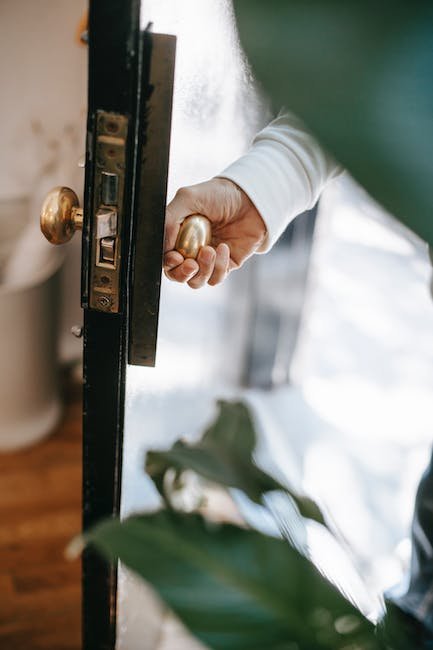Have you ever felt that chill down your spine when you come home to find your door ajar, seemingly untouched? The idea of someone gaining access to our personal space without our knowledge is unsettling, to say the least. It is in moments like these that we realize the importance of securing our homes. But what if the realm of security we trust in could be compromised by a method so deceptively simple? Welcome to the intricate world of lock bumping, where science meets deception. In this article, we will unveil the secrets behind this cunning technique and explore the measures we can take to safeguard our homes against this silent intruder. Prepare to delve deep into the realm of lock manipulation, where knowledge is power, and fortifying our sense of security becomes paramount.
Table of Contents
- Understanding Lock Bumping: A Comprehensive Analysis
- Exploring the Vulnerabilities: The Inner Workings of Locks
- Enhancing Home Security: Effective Measures to Prevent Lock Bumping
- Lock Bumping Prevention Strategies: Expert Recommendations for Homeowners
- Mastering Lock Bumping: Insights from the Science of Locksmithing
- Q&A
- Insights and Conclusions

Understanding Lock Bumping: A Comprehensive Analysis
Lock bumping is a technique that has gained notoriety in the realm of lock picking. With this comprehensive analysis, we aim to shed light on this intricate method and provide a deeper understanding of its workings.
In simple terms, lock bumping involves using a specially crafted key, often referred to as a bump key, to manipulate the pins within a lock cylinder and gain access without damaging the lock itself. This technique relies on the principle of kinetic energy transfer, where a bump force is applied to the key, creating a rapid succession of vibrations that cause the pins to momentarily jump, allowing the lock to be turned.
Understanding the potential risks associated with lock bumping is crucial for both homeowners and security professionals alike. While lock bumping has garnered attention for its simplicity and effectiveness, it also highlights the vulnerabilities of traditional pin-tumbler locks. However, it is essential to note that not all locks are vulnerable to this technique, as some manufacturers have implemented security features to counteract bumping attacks.
To protect against this technique, it is recommended to consider the following preventive measures:
– Upgrade to high-security locks: Opt for locks that incorporate anti-bumping features, such as mushroom pins or specialized driver pins, which make it significantly harder for bump keys to be successful.
– Install a security system: Adding an alarm system, security cameras, or motion sensors can deter potential intruders and provide an extra layer of protection.
– Reinforce doors and frames: Ensure that all entry points are secure by reinforcing doors and frames with heavy-duty materials, such as solid wood or metal.
– Engage a locksmith: Consulting with a reputable locksmith can help assess the security of your locks and provide recommendations on additional measures that can be taken.
By comprehensively understanding lock bumping, its techniques, and vulnerabilities, individuals can make informed decisions to enhance their security and safeguard against potential threats. Stay informed, stay secure!
Exploring the Vulnerabilities: The Inner Workings of Locks
Delving deeper into the complex mechanics behind locks reveals a fascinating realm that lies hidden within the mundane. Locks, these seemingly impenetrable guardians of our security, have long held the curiosity of both enthusiasts and mischievous minds alike. Behind their unassuming exteriors lie intricate systems, each with its unique strengths and vulnerabilities.
Locks come in various types, from the humble pin tumbler locks to the more sophisticated electronic locks. Their designs incorporate an array of ingenious mechanisms that work harmoniously to ward off potential intruders. However, as we embrace the ingenuity of lock technology, so too does our understanding of the vulnerabilities present within these intricate systems.
- Pick Attacks: Lock pickers, skilled in the art of manipulation, can exploit weaknesses in locks to gain unauthorized access. By skillfully maneuvering slender tools within the lock mechanism, they can bypass intricate parts and manipulate the pins or tumblers.
- Lock Bumping: Ever heard of the silent intruder? Lock bumping, a technique using a specially crafted key, allows even those lacking technical skill to breach locks swiftly and quietly. This method utilizes the transfer of kinetic energy to momentarily misalign the internal pins, permitting effortless entry.
- Key Duplication: Keys, though essential for authorized access, may become a liability in the wrong hands. Skilled individuals can replicate keys either by illicit means or through unauthorized duplication services, effectively bypassing the security measures associated with locks.
The inner workings of locks never cease to fascinate, as their vulnerabilities provide a constant challenge for manufacturers and security experts. By acknowledging these weaknesses, we broaden our understanding and strengthen our ability to protect what matters most.

Enhancing Home Security: Effective Measures to Prevent Lock Bumping
When it comes to keeping your home safe and secure, taking proactive measures to prevent lock bumping is crucial. Lock bumping is a technique used by burglars to open standard pin tumbler locks quickly and discreetly, leaving no sign of forced entry. Thankfully, mitigating the risk of lock bumping can be achieved through a few effective security measures:
- Upgrade your locks: Investing in high-security locks is the foundation of protecting your home against lock bumping. Consider installing Grade 1 deadbolt locks, which have enhanced features to resist bumping attempts.
- Install a security system: Having a reliable security system in place not only deters potential burglars but also alerts you and the authorities in case of a break-in. Opt for a system that includes window and door sensors, motion detectors, and surveillance cameras.
- Reinforce doors and windows: Secure your home further by reinforcing vulnerable entry points. Install door jamb reinforcements, security film, and window locks to add an extra layer of protection.
- Consider smart technology: Embrace the benefits of smart technology by integrating it into your home security measures. Smart locks allow for remote access and monitoring, empowering you to control and track entry to your home conveniently.
By implementing these effective measures, you can significantly decrease the vulnerability of your home to lock bumping and enhance overall security. Protecting your home and loved ones should always be a top priority, and taking the necessary precautions can bring peace of mind in an uncertain world.
Lock Bumping Prevention Strategies: Expert Recommendations for Homeowners
When it comes to home security, one cannot underestimate the importance of preventing lock bumping – a technique used by burglars to gain unauthorized access to your property. To help homeowners safeguard their homes, we’ve gathered some expert recommendations to make your locks more resistant to this nefarious practice.
- Invest in High-Security Locks: Upgrade your locks to options specifically designed to resist lock bumping, such as those with anti-bump pins or sidebar mechanisms. These locks are a formidable barrier for would-be intruders.
- Reinforce Door Frames: Ensure that your door frames are sturdy and properly reinforced. Weak frames can make it easier for burglars to force their way in. Consider installing door reinforcement plates made of steel to provide an extra layer of protection.
- Install Deadbolt Locks: Deadbolt locks are an effective deterrent against lock bumping. Opt for models with a minimum one-inch throw and ensure they are properly installed into the door frame to prevent prying.
- Add Security Pins: Consult a professional locksmith to add security pins to your existing lock cylinders. These pins are designed to disrupt the bumping technique, making it considerably more challenging for intruders to compromise your locks.
- Consider Electronic Locks: Electronic locks equipped with keyless entry systems offer heightened security and convenience. By eliminating the use of traditional keys, they eliminate any risk of lock bumping altogether.
By implementing these expert recommendations, homeowners can significantly reduce the risk of lock bumping and enhance the overall security of their homes. Stay one step ahead of potential burglars by fortifying your locks and securing your property with these proactive measures.
Mastering Lock Bumping: Insights from the Science of Locksmithing
Bumping locks is a skill that has been perfected over centuries, and today we delve into the fascinating science behind mastering this technique. Locksmithing is an art form that requires both technical knowledge and hands-on experience. By understanding the intricacies of how locks work, locksmiths have developed ingenious methods to manipulate them.
One key insight from the science of locksmithing is the concept of pin tumblers. These tiny metal pins are the foundation of a lock’s security. When a key is inserted, it pushes the pins to the correct height, allowing the lock to turn. In lock bumping, a specially crafted bump key is used to mimic the action of a regular key. As the key is inserted and bumped, the pins momentarily separate, allowing the lock to be manipulated.
Another crucial concept in mastering lock bumping is the phenomenon of vibration. By applying controlled vibrations to the lock, locksmiths can unsettle the pin tumblers and exploit their temporary misalignment. This phenomenon can be enhanced by using specialized tools, such as vibration picks or electric bump guns.
- Pin tumblers are the foundation of a lock’s security
- Bump keys mimic the action of a regular key
- Controlled vibrations unsettle pin tumblers
- Specialized tools enhance the lock bumping process
Mastering lock bumping is a fascinating journey into the world of locksmithing. Understanding the science behind the technique empowers locksmiths to manipulate locks efficiently and ethically. It is an art that tests their skills, creativity, and adaptability, making them masters of their craft.
Q&A
What is lock bumping and how does it work?
Lock bumping is a technique used to open pin-tumbler locks using a specially crafted key and a bumping tool. When the bump key is inserted into the lock and gently tapped, it causes the pins to momentarily jump, allowing the lock to turn easily.
Is lock bumping a common method of breaking into homes?
Lock bumping has gained popularity among burglars due to its simplicity and effectiveness. It is estimated that over 90% of pin-tumbler locks can be bumped open, making it a concern for homeowners and security professionals.
What are the potential risks of lock bumping?
Lock bumping poses a significant security risk, as it allows intruders to quickly gain access to locked premises without leaving any signs of forced entry. It can lead to theft, property damage, and compromise the safety of individuals within the premises.
How can I protect my home from lock bumping?
There are several measures you can take to prevent lock bumping. One effective method is to upgrade your locks to high-security options, such as bump-resistant locks or those with complex pin systems. Another option is to reinforce your doors with additional security features like deadbolts or door reinforcement plates.
Are there any DIY solutions to deter lock bumping?
While there are no foolproof DIY solutions, you can try installing anti-bump pins or cylinders. These specialized components make it significantly more difficult to execute a successful bumping attack. However, it is always recommended to consult a professional locksmith for the best security options.
Is lock bumping an issue for all types of locks?
Lock bumping primarily affects pin-tumbler locks, which are among the most commonly used locks in residential and commercial settings. However, other types of locks, such as wafer locks or smart locks, are generally immune to lock bumping.
Can lock bumping be detected?
Lock bumping is often difficult to detect, as there are no visible signs of forced entry. However, if you find several locks in your home having their keyways scratched or damaged, it might indicate an attempted or successful bumping attack.
What should I do if I suspect my locks have been bumped?
If you suspect your locks have been compromised through lock bumping, it is crucial to take immediate action. Consider contacting a professional locksmith to assess the security of your locks and install more robust alternatives to prevent future break-ins.
Insights and Conclusions
In a world where security is paramount, understanding the science behind lock bumping has never been more crucial. By delving into the intricate mechanisms that form the foundation of our locks, we peel back the layers of vulnerability that assail our sense of safety. From its inception as a method used primarily by locksmiths to its sinister underbelly that threatens our homes and businesses, lock bumping is an art that demands attention.
Yet amidst this clandestine world of locks and keys, fear not, for there are steps we can take to fortify our defenses. With knowledge as our trusted guide, we have uncovered the secrets that lock bumping harbors and unearthed the methods to prevent it. From selecting robust lock designs to implementing cutting-edge security technologies, we now possess an arsenal of tools to safeguard our most valued possessions.
By acquainting ourselves with the intricate dance between pins and tumblers, we have unlocked a new level of consciousness. Armed with this understanding, we become stewards of our own security, actively countering the silent threat that lurks at our doorsteps. Let us embrace this newfound knowledge, transforming it into a shield that thwarts the malevolent intentions of those who seek to compromise our peace of mind.
So, dear reader, take these insights and empower yourself. Share them with friends and family, for the strength of our security lies in unity. Let us stand together against the dark forces that endeavor to exploit our vulnerabilities. Through vigilance, innovation, and a collective commitment to safety, we can redefine what it means to protect our sanctuaries.
The science behind lock bumping may have once been shrouded in mystery, but now it stands exposed, and with that exposure comes the opportunity for transformation. So, lock your doors, fortify your defenses, and reclaim the tranquility that is rightfully yours. May the pursuit of knowledge guide your steps, and may your journey towards security be one of triumph and peace.
As an affiliate, my content may feature links to products I personally use and recommend. By taking action, like subscribing or making a purchase, you’ll be supporting my work and fueling my taco cravings at the same time. Win-win, right?
Want to read more? Check out our Affiliate Disclosure page.